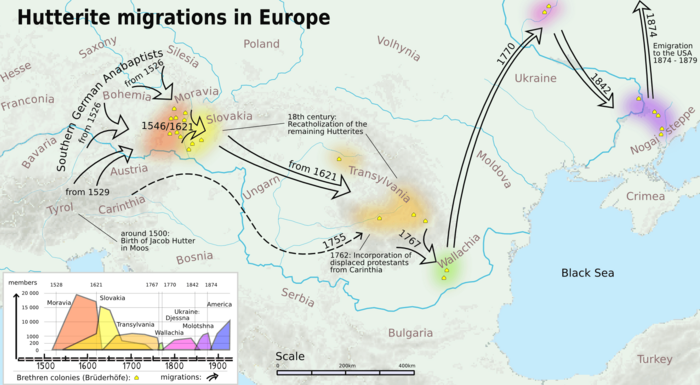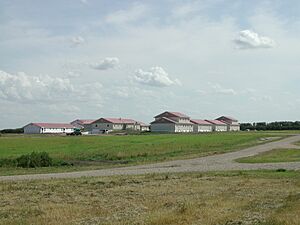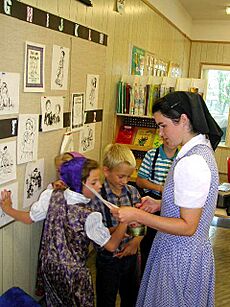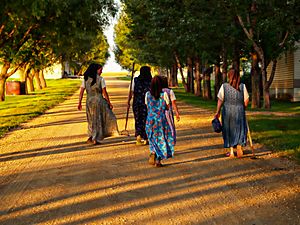Hutterites facts for kids
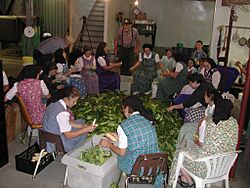
Hutterite women at work
|
|
| Total population | |
|---|---|
(2025) |
|
| Founder | |
| Jakob Hutter | |
| Regions with significant populations | |
| North America (notably South Dakota, North Dakota, Montana, Washington, Oregon, Manitoba, Alberta, British Columbia, and Saskatchewan) | |
| Religions | |
| Anabaptist | |
| Scriptures | |
| The Bible | |
| Languages | |
| Hutterite German, Standard German, English |
The Hutterites are a special group of Christians who live together in communities. They are also called Hutterian Brethren. Like the Amish and Mennonites, their beliefs come from a religious movement in the early 1500s called the Radical Reformation. Hutterites believe in living in shared communities where everyone works together and shares everything.
Their founder, Jakob Hutter, started the first Hutterite communities in 1528 in a place called Tyrol (which is now part of Italy). Hutterites believe in sharing all their belongings and in being peaceful, meaning they do not fight or join the military. Because of these beliefs, they faced many challenges and had to move from country to country for hundreds of years. They traveled through central and eastern Europe, then to Russia in 1770, and finally to North America about 100 years later. Today, most Hutterites live in Western Canada and the Great Plains of the United States. Their population has grown from about 400 people to around 50,000.
Contents
Hutterite History
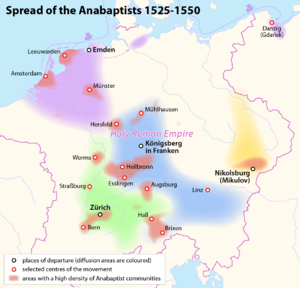
How the Hutterites Started
The Hutterites are part of a larger Christian movement called Anabaptism. This movement began in Switzerland in 1525. Early Anabaptists believed that people should be baptized as adults, not as babies. This idea was different from what many other churches taught at the time.
One of the first Anabaptists, Jörg Blaurock, helped spread these ideas. Many early Anabaptists, including Jakob Hutter, faced difficult times because of their beliefs.
Moving to Moravia and Hungary
Because they faced challenges in other places, many early Anabaptists, including the Hutterites, moved to Moravia (part of today's Czech Republic) in the 1500s. This area was more accepting of different religious groups.
Under the leadership of Jakob Hutter, the Hutterites developed their unique way of living in shared communities. This idea came from the New Testament in the Bible, where early Christians shared everything.
A key belief for Hutterites is nonresistance. This means they do not take part in military activities or wars. This belief often led to them being forced to leave places or facing difficult times.
For many years, the Hutterites thrived in Moravia and then expanded into Upper Hungary (today's Slovakia). They built many settlements, called Bruderhofs, and their numbers grew to tens of thousands. However, wars and a terrible sickness called the Bubonic plague caused great hardship. In 1622, they were forced to leave Moravia and moved to Hungary.
Moving to Transylvania and Wallachia
In 1621, a prince invited Hutterites to come to Transylvania (part of today's Romania) because he needed skilled workers. A large group of Hutterites moved there.
Later, in 1756, another group of Christians joined the Hutterites in Transylvania. This new group helped to bring back the Hutterite way of life, including their shared communities. They also changed the Hutterite language to a different German dialect.
In 1767, the Hutterites had to move again, this time to Wallachia (another part of today's Romania). They faced many difficulties there, including lawlessness and war.
Life in Ukraine
In 1770, about 60 Hutterites moved to Ukraine, which was then part of the Russian Empire. They were given land and a chance for a new start. More Hutterites joined them there.
Over time, the Hutterites faced challenges with land ownership. They also had some disagreements among themselves about whether to continue living in shared communities or to own individual farms. For a while, they gave up their shared living.
In 1842, they moved to a better area in Ukraine called Molotschna, where they learned new farming methods from the Mennonites. This helped them become more successful.
Around this time, some Hutterites decided to restart the shared community way of life. This led to the creation of the three main Hutterite groups we know today: the Schmiedeleut, the Dariusleut, and the Lehrerleut.
In the 1860s and 1870s, new laws in Russia made the Hutterites consider moving again. Schools started teaching in Russian, and young men had to join the military.
Coming to the United States
Between 1874 and 1879, almost all Hutterites, about 1,265 people, moved to the United States. They came because of the new military service law in Russia.
About 800 Hutterites chose to buy their own farms, while about 400 decided to start new shared communities. Most Hutterites today are descended from these 400 people who continued the communal lifestyle. They settled in the Dakota Territory.
During World War I, Hutterites faced difficulties in the United States because they refused to join the military due to their peaceful beliefs. Two Hutterite men even died in prison.
Moving to Canada
Because of the challenges they faced in the United States, many Hutterites moved to the Canadian provinces of Alberta, Manitoba, and Saskatchewan. All but one of their communities in the U.S. were left behind.
During World War II, there were still some challenges for Hutterites in Canada. Laws were passed that limited how much their communities could grow. However, these laws were later changed.
Today, most Hutterites live in Canada. As of March 2018, about 34,000 Hutterites lived in 350 communities in Canada, which is about 75% of all Hutterites in North America. These communities often run large farms that produce grains, eggs, meat, and vegetables.
Partial Return to the U.S.
During the Great Depression, some Hutterites moved back to the United States, especially to South Dakota and Montana. They bought back some of the communities that had been left empty.
Hutterite Beliefs
Hutterites have a special book called Account of Our Religion, Doctrine and Faith that explains their beliefs. It was written by Peter Riedemann in the 1540s.
Hutterite beliefs are based on the Schleitheim Confession, an important Anabaptist statement of faith. Key beliefs include:
- Adult Baptism: People are baptized when they are old enough to understand and choose their faith.
- Peaceful Living: Hutterites believe in nonviolence and do not participate in wars or military service.
- Community of Goods: They share all their property and resources. This is inspired by passages in the Acts of the Apostles in the Bible.
- Separation from the World: They try to live separately from the outside world and its influences.
Hutterite Community Life
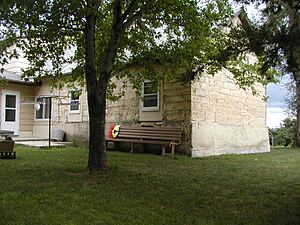
Hutterite communities are called "colonies." They are usually in rural areas and often rely on farming or ranching for their income. In recent years, some colonies have also started manufacturing businesses.
A colony tries to be mostly self-sufficient. This means they build their own buildings, fix their own equipment, and make their own clothes. However, they do buy some food and other goods from outside.
Hutterite farming today is very modern and uses advanced equipment.
How Colonies are Run
Hutterite colonies are mostly led by men. Women have important roles in cooking, making medical decisions, and choosing fabrics for clothing.
Each colony has three main leaders:
- The Minister is the spiritual leader and also the president of the colony's business.
- The Secretary is like the manager, handling money, records, and the colony's budget. People often call him the "Boss."
- The Assistant Minister helps with church duties and often teaches German to the children.
There are also other "boss" positions for different areas, like the "Farm Boss" who manages all the farming, or the "Hog Boss" who manages the pigs. These leaders are chosen by a vote.
Important decisions are made by a council of senior men, and then voted on by all the married men in the colony. Women and children do not formally vote, but their opinions can still influence decisions.
All colonies within a Hutterite branch (like Lehrerleut or Dariusleut) also follow the decisions of a larger group of leaders called the "Bishop" council.
Sharing Everything
Hutterites practice a nearly complete community of goods. This means the colony owns all property, and everyone shares in the common resources. There are no individual paychecks. Instead, the colony provides for each member and their family. Any money earned is put back into the community.
Families live in their own homes, but these homes belong to the colony. People have very few personal belongings. Lunch and dinner are usually eaten together by the whole colony in a shared dining room, with men and women sitting separately. Breakfast is often eaten in individual homes.
New Colonies
A Hutterite colony usually has about 10 to 20 families, with a total of 60 to 250 people. When a colony gets too big, they decide to create a "daughter" colony. This helps them stay economically strong and spiritually connected.
The process of splitting a colony is very organized, especially for the Lehrerleut group. They buy new land and build all the buildings for the new colony before anyone knows who will move there. The colony leaders divide the families into two groups, trying to make them as equal as possible. They also decide which group will take on certain farming or business operations.
Once everything is ready, the minister prays and draws a piece of paper from a hat. The paper says which group will move to the new daughter colony. This process can be difficult, but it ensures a fair decision.
Farming and Manufacturing
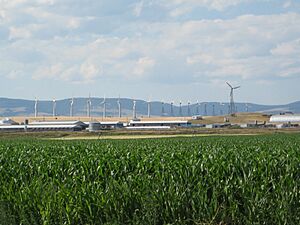
Hutterite colonies often own large areas of land and use high-quality equipment. Many run large-scale farms for hogs, dairy, turkeys, chickens, and eggs.
More and more Hutterite colonies are also starting manufacturing businesses, like making plastics, metal parts, cabinets, or stone products. This is similar to how Hutterites lived in Europe before they came to North America, when they relied more on crafts and manufacturing. This change helps them earn enough money to buy new land and build new colonies when they need to split.
Using Technology
Hutterites use modern technology, but they might limit some uses. They try to keep a distance from the outside world. For example, television and sometimes the internet are not allowed in homes. Many colonies used to have only one central telephone, but now cell phones are very common for both business and talking with friends and family.
Hutterite farms use very advanced equipment, often as good as or better than other farms. Some colonies allow computers for business and farm management. Young Hutterites often use computers and the internet to connect with friends and family.
Education for Children
Hutterite children go to school in a schoolhouse right on the colony. An "outside" teacher is usually hired to teach subjects like English. Children also have a "German Teacher" from the colony who teaches them German, Bible lessons, and helps them memorize scripture.
In some colonies, children might leave school after 8th grade or at age 15. However, many colonies now offer a full high school diploma, and some even support university degrees. Sometimes, children might miss school days to help with duties on the colony.
Main Hutterite Groups
There are three main Hutterite groups in North America: the Schmiedeleut, the Dariusleut, and the Lehrerleut. While they all share the same basic beliefs, they have some differences in their clothing styles and how their communities are organized. These differences are mostly based on their traditions and where they live.
There are also other related groups, like the Bruderhof Communities, who share some Hutterite ideas but are more open to outsiders. Another group, the Prairieleut, were Hutterites who chose to live on individual farms when they first came to America. Most of them later joined Mennonite churches.
Since 1992, the Schmiedeleut group has split into two parts, called "Group One" and "Group Two," because of disagreements. Group One colonies are generally more open to things like higher education, musical instruments, and technology.
Photography and Identity
Hutterites have had discussions about whether their pictures should be taken for things like driver's licenses. Some Hutterites believe that taking photographs goes against their religious beliefs, based on the Ten Commandments.
In 2009, the Supreme Court of Canada decided that Hutterites must have a digital photo on their driver's licenses to help prevent identity theft.
Hutterite Clothing
Hutterite clothing is often simple, but it can be colorful, especially for children. Most clothes are made within the colony. Shoes used to be homemade but are now usually bought from stores.
Men usually wear black jackets and pants. Their shirts have long sleeves and collars. Men's pants are held up by suspenders and do not have back pockets.
Women and girls wear a dress with a blouse underneath. They also wear a kerchief-style Christian headcovering on their heads. The pattern on the kerchief can show which Hutterite group a woman belongs to: large dots for Lehrerleut, small dots for Dariusleut, and no dots for Schmiedeleut. Young girls wear bright, colorful caps.
For church, both men and women wear dark clothing. Men wear dark hats, and women wear a plain jacket and a black apron.
Hutterite Language
Hutterites speak a special dialect of German called Hutterite German, or Hutterisch, among themselves. It's like a language of its own. It comes from a dialect spoken in Tyrol in the 1500s, but it was later influenced by a dialect from Carinthia. When they have religious services, Hutterites use a classic Lutheran German.
Hutterite Population and Where They Live
| Historical population | ||
|---|---|---|
| Year | Pop. | ±% |
| 1980 | 24,326 | — |
| 1995 | 30,000 | +23.3% |
| 2018 | 47,500 | +58.3% |
| 2020 | 53,000 | +11.6% |
| Estimates: | ||
In 1995, there were about 30,000 Hutterites in North America. Today, their population is estimated to be over 55,000.
About 75% of all Hutterites live in Canada, and the other 25% live in the United States.
- Canada
| Province | 2016 census |
|---|---|
| Alberta | 16,935 |
| Manitoba | 11,275 |
| Saskatchewan | 6,250 |
In 2016, there were 370 Hutterite colonies in Canada. Most of them were in Alberta (175), Manitoba (110), and Saskatchewan (70). The total Hutterite population in Canada in 2016 was 35,010 people.
- United States
As of March 2018, there were 120 colonies in the United States. Most were in South Dakota (54) and Montana (50). There were also colonies in Minnesota, North Dakota, Washington, and Oregon.
In 2020, the U.S. Hutterite population was about 15,531 people.
| State | 2020 estimate |
|---|---|
| South Dakota | 7,567 |
| Montana | 5,498 |
| Minnesota | 976 |
| North Dakota | 764 |
| Washington | 592 |
| Other | 134 |
How the Population Grows
The Hutterite population has grown a lot over the years, partly because families traditionally had many children. However, the number of children per family has decreased over time. In the 1950s, families might have had around ten children, but by 2010, it was closer to five. Hutterite families still have more children than the average North American family.
| Year | Hutterites | South Dakotans |
|---|---|---|
| 1950 | 45.9 | 23.4 |
| 1970 | 43.0 | 14.7 |
| 1990 | 35.2 | 12.1 |
| Year | Fertility rate |
|---|---|
| 1940 | 10.57 |
| 1950 | 9.83 |
| 1970 | 7.22 |
| 1980 | 6.29 |
| 1990 | 4.63 |
See also
 In Spanish: Huteritas para niños
In Spanish: Huteritas para niños
- Amish and Mennonite Heritage Center
- Christian pacifism
- Peace churches
- Plain people
- Simple living


